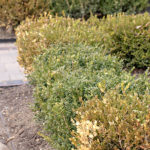Boxwood blight update

Boxwood blight is a fungal disease of boxwood that results in the defoliation and decline of boxwood plants. Once it’s in the landscape it is very costly and difficult to control with fungicides. The boxwood blight fungus has a short life cycle and infections can spread quickly between plants, especially under humid, warm and wet conditions that favor disease development.
The main way that this disease is spread is through the movement of infected plants, cuttings, and boxwood debris. The sticky fungus spores are also spread on contaminated tools and equipment, worker's clothes, and water. The spores are unlikely to travel long distances through the wind. All plants infected with the fungus should be destroyed, as the chance of further spreading the fungus is highly probable. Limiting the spread of this sticky fungus is very difficult and can only be accomplished by following good sanitation practices.

Boxwood blight has been found in Michigan. Because of this we will NOT accept any returns on boxwood once they have left the nursery. We will also ask that you do not bring any boxwood plants, leaf litter, or clippings into our nursery. We reserve the right to not load any vehicle that has boxwood or debris from outside of our nursery. Please do not bring in any samples of boxwood that you are trying to match - take several pictures of the plant you are trying to match and we will help the best we can.
Boxwood blight can look like many other issues that boxwood can have, such as leaf spot, winter burn, and other non-threatening fungal diseases. This means that:
The only way to confirm whether a plant has boxwood blight is to submit samples to a professional plant disease diagnostic lab.

NOT Boxwood Blight - this is winter damage.
Cooperative extension agents will be able to help you in submitting samples if you need help. Affected branches, stems, and leaves make the best samples, don’t forget to also take pictures.
If you do suspect that a plant has boxwood blight, you can send a sample to MSU Diagnostic Services. You can contact them at http://www.pestid.msu.edu/ or through the Michigan Department of Agriculture.
More information and pictures here: Boxwood Blight
